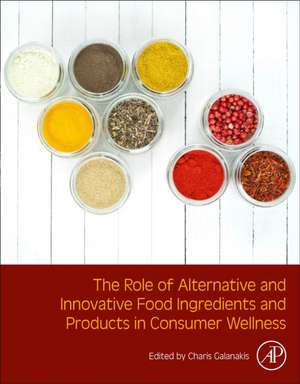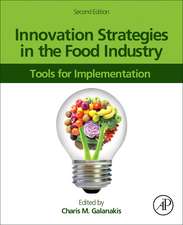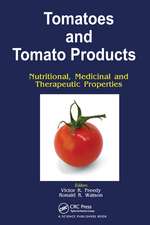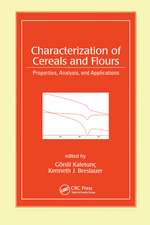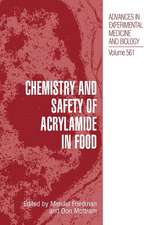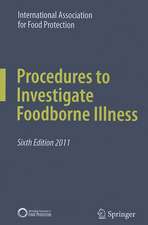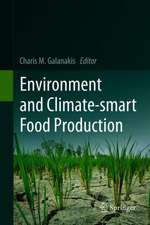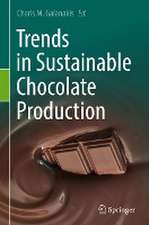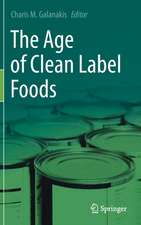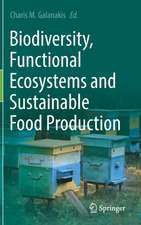The Role of Alternative and Innovative Food Ingredients and Products in Consumer Wellness
Editat de Charis M. Galanakisen Limba Engleză Paperback – 19 iul 2019
Food scientists, food technologists and nutrition researchers working on food applications and food processing will find this book extremely useful. In addition, those interested in the development of innovative products and functional foods will also benefit from this reference, as will students who study food chemistry, food science, technology, and food processing in postgraduate programs.
- Connects integrally new and reconsidered food ingredients with innovative food products
- Addresses consumer wellness as it relates to food ingredients and functional foods
- Analyzes food products and processes with the highest market potential
Preț: 913.07 lei
Preț vechi: 1264.33 lei
-28% Nou
Puncte Express: 1370
Preț estimativ în valută:
174.74€ • 180.27$ • 147.89£
174.74€ • 180.27$ • 147.89£
Carte tipărită la comandă
Livrare economică 25 februarie-11 martie
Preluare comenzi: 021 569.72.76
Specificații
ISBN-13: 9780128164532
ISBN-10: 0128164530
Pagini: 366
Dimensiuni: 191 x 235 mm
Greutate: 0.63 kg
Editura: ELSEVIER SCIENCE
ISBN-10: 0128164530
Pagini: 366
Dimensiuni: 191 x 235 mm
Greutate: 0.63 kg
Editura: ELSEVIER SCIENCE
Public țintă
nutrition researchers, food scientists, technologists, engineers, and chemists working in food science; new product developers; researchers, academics and professionals working in the food industry. The book could also be used in postgraduate programs focused on food chemistry, food science and technology and food processingCuprins
1. Wellness Ingredients and Functional Foods
2. Fruit-based Functional Foods
3. The Concept of Superfoods in Diet
4. Microalgae as Healthy Ingredients for Functional Foods
5. Edible Insects and Related Products
6. Low Glycemic Index Ingredients and Modified Starches In Food Products
7. Products Based on Omega-3 Polyunsaturated Fatty Acids & Health Effects
8. Gluten-free Products
9. Food Industry Processing By-products in Foods
10. Pro- and Prebiotic Foods that Modulate Human Health
11. Production and Recovery of Bioaromas Synthesized by Microorganisms
2. Fruit-based Functional Foods
3. The Concept of Superfoods in Diet
4. Microalgae as Healthy Ingredients for Functional Foods
5. Edible Insects and Related Products
6. Low Glycemic Index Ingredients and Modified Starches In Food Products
7. Products Based on Omega-3 Polyunsaturated Fatty Acids & Health Effects
8. Gluten-free Products
9. Food Industry Processing By-products in Foods
10. Pro- and Prebiotic Foods that Modulate Human Health
11. Production and Recovery of Bioaromas Synthesized by Microorganisms
Recenzii
"Humans have been adding supplements to foods for a long time. When we added quinine (first extracted from cinchona bark) to our gin and tonic, it was not for its calorific value, but rather for its antimalarial properties. Similarly, today, we aim to reduce illness and better our diet through eating bioactive compounds in the variety of ways described in this book. It is described as a reference, beneficial to food scientists, technologists, nutrition researchers and food chemistry students, but I certainly believe it accessible to all who are interested in the latest food technologies available, as well as those which might be available in the future. The book deals largely with natural (rather than synthetic) sources of bioactive ingredients and the functional foods where they may be found. Individual chapters focus on fruit, cereal, microalgae, insect, fish-based and bacterial sources of compounds. The book also describes the methods in which nutrients are commonly extracted, where they may be medically useful, and to which foods the bioactive ingredients may be added. Of interest are comments on how the food technology industry needs legislative support in order to successfully transform food waste into useable protein/fibre/vitamins or to define more closely exactly which foods can be branded ‘superfoods’. The success of microalgae and insect food industries also requires a societal shift for many, but in any event could play a larger role in global animal feed. The world is becoming smaller with regard to exotic food information. Research into the omega-3 eating people of Greenland suggests that cardiovascular disease doesn’t have to be a consequence of a high-fat diet and that historical Brazilian consumers of the açaí berry did so to improve digestion. This book, with chapter contributions from all corners of the globe, highlights the modern global search for better food ingredients." --The Biochemist
